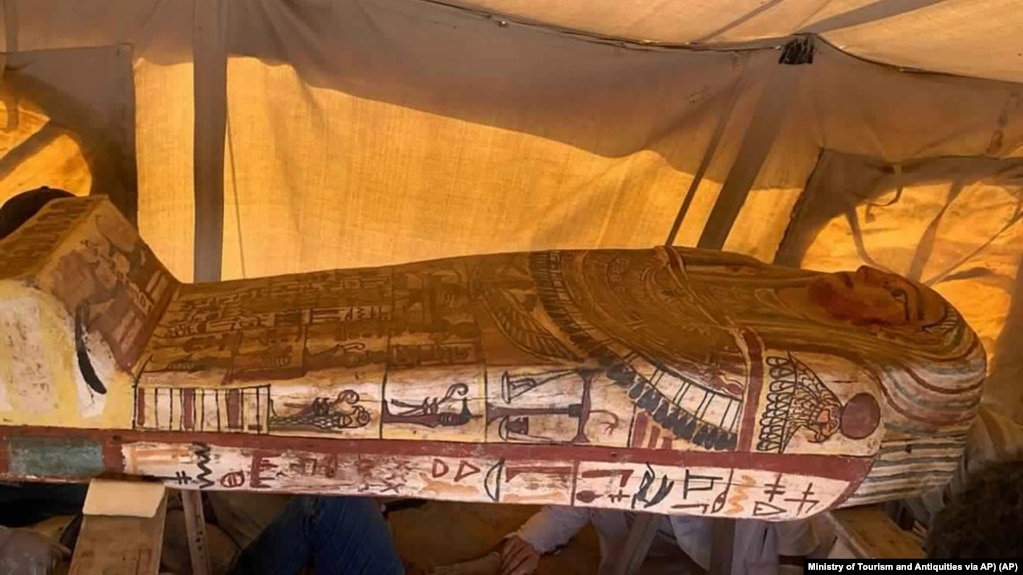
This Sept. 2020 photo provided by the Ministry of Tourism and Antiquities shows one of more than two dozen ancient coffins unearthed near the famed Step Pyramid of Djoser in Saqqara, south of Cairo, Egypt. (Ministry of Tourism and Antiquities via AP)
In Egypt, workers dig and remove sand to create a new opening at a busy archaeological site outside of Cairo. They are at the bottom of the Step Pyramid of Djoser, probably the world’s oldest pyramid. This new dig has found many additional artifacts.
As the world slowly recovers from the coronavirus pandemic, Egypt has been trying for months to persuade visitors to come to its archaeological locations and museums. Officials are hoping the new discovery will bring in the visitors – and their money.
But like countries elsewhere, Egypt continues to battle the coronavirus. It is struggling to get its people vaccinated. In early May, the government announced that 1 million people had been vaccinated, though that number is believed to be higher now.
Meanwhile, officials have continued to tell the world about their new discoveries.
In November, archaeologists announced the discovery of at least 100 coffins dating back to the Pharaonic Late Period and Greco-Ptolemaic era. They also found 40 gold-covered statues thought to have been buried 2,500 years ago. A month earlier, they discovered 57 additional coffins at the same place, the necropolis of Saqqara that includes the Step Pyramid.
“Saqqara is a treasure,” Tourism and Antiquities Minister Khaled el-Anany told The Associated Press. He estimated that only 1 percent of the treasures hidden there have been found.
In April, Zahi Hawass, Egypt’s best-known archaeologist, announced the discovery of a 3,000-year-old lost city in southern Luxor. It has the remains of houses, tools and other artifacts that date to Amenhotep III of the 18th dynasty. He ruled from 1390-1353 BC. This was Egypt’s golden age.
That discovery was followed by a televised parade celebrating the moving of 22 royal mummies to their new home: the National Museum of Egyptian Civilization. It is a large, new building just south of the capital.
The Red Sea town of Sharm el-Sheikh is well-liked by visitors, and is now home to a new archaeological museum. The Cairo International Airport also houses a new museum. Officials have said they plan to open the new Grand Egyptian Museum next to the Giza Pyramids by January. Prices to enter archaeological sites have been lowered, as has the cost of visas to enter the country.
In 2019, foreign visitors brought an estimated $13 billion to the country as some 13.1 million people came to see its museums and archaeological sites.
But in 2020, only 3.5 million foreign visitors came, minister el-Anany said. He added that the number of visitors had increased in the first months of 2021, but he gave no exact numbers.
“Egypt is a perfect destination for post-COVID,” el-Anany said, adding that most of the places to visit are “open air.”
It is, however, unclear if Egypt has the virus under control.
It has recorded more than 15,000 deaths and is still seeing more than a thousand new cases every day. Numbers are thought by many to be much higher. Officials have arrested doctors and others who question the government’s actions or numbers.
Egypt closed its borders completely until the summer of 2020, but later welcomed visitors back. They were permitted first to visit Red Sea towns. Now, they can go to the heart of the country: Cairo and the Nile River Valley that holds most of its famous archaeological sites. Visitors still require a COVID-19 test result to enter the country.
Amanda, a 39-year-old from Austria, returned to Egypt in May. It was her second visit in four years.
“Once they opened, I came,” she said. “It was my dream to see the Pyramids again.”
Words in This Story
archaeology – n. the study of past human life and activities by examining bones, tools, etc., of ancient people
pyramid – n. a large structure with a three- or four-sided base and sides that meet in a point at the top
artifact – n. an object (such as a tool or weapon) that was made by people in the past
coffin – n. a box in which a dead body is buried
dynasty – n. a series of rulers from the same family
mummy – n. a dead body covered in cloth, especially from ancient Egypt
destination – n. the place where someone or something is going
Comprehension Quiz
1. What is the story mainly about?
2. Why do workers dig and remove sand?
3. In early May, how many people had been vaccinated?
4. Who is Zahi Hawass?
5. How many visitors come in 2020?